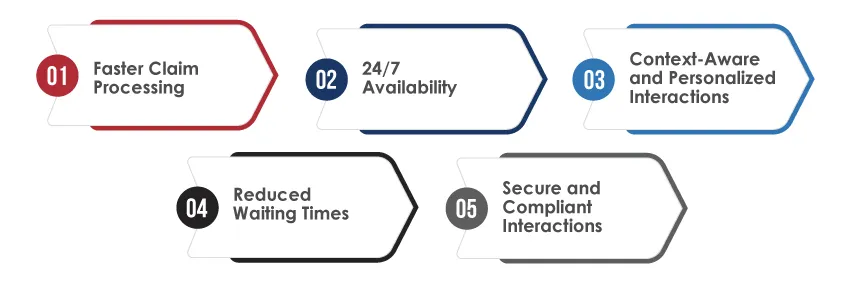Table of Contents
- Voice AI and Conversational Interfaces Overview
- Why Voice AI Is a Game-Changer for Insurance CX?
- Voice AI and Conversational Interfaces Real-World Use Cases
- Navigation Privacy and Trust Risks
- How can Tx Assist in Making Voice AI Better for the Insurance Sector?
- Summary
The global voice AI agents’ market is expected to reach 47.5 billion By 2034, growing at a CAGR of 34.8% from 2025 to 2034. One thing is sure, since this growth, AI-enabled customer service is becoming the quickest way to deliver personalized customer service across industries, especially in insurance. This technology enables insurers to provide proactive, impactful experiences for better user engagement. As insurance companies look for tech innovations to reduce operational costs while improving customer experience, voice AI and conversational interfaces will truly lead the change.
Voice AI and Conversational Interfaces Overview
Voice AI and conversational interfaces are artificial intelligence models that engage in human-like conversations. They combine NLP and ML technologies to understand and interpret human language and respond with relevant answers. There are two types of conversational interfaces:
• Voice assistants, where input and output are spoken
• Chat assistants: where the input mechanism is via a keyboard, and the output comes in text.
Here are some examples of voice assistants that have become the key drivers behind the popularity of conversational interfaces:
• Amazon Alexa has around 50,000 functionalities and is compatible with 20,000 connected devices. More than 3,500 brands use it.
• Google Voice Assistant supports more than 30 languages and will soon be available in 80 different countries.
• Microsoft and Amazon announced a partnership to improve the functionality and customer experiences of their voice assistants, Cortana and Alexa.
Why Voice AI Is a Game-Changer for Insurance CX?
It is a fact that insurance does not offer seamless and delightful customer service. Long waiting queues, confusing plans, and repetitive conversations stop customers from calling insurers. But voice AI changes all this by quietly changing how insurance companies interact with their target customers. From personalized chat service to faster claim processing, voice AI is shifting insurance from a chore to a smooth transaction. Here’s how it’s happening:
Faster Claim Processing:
The traditional approach for filing a claim (known as First Notice of Loss) involves being on hold, giving detailed information, and hoping not to miss anything. With Voice AI, customers can simply speak with an AI-enabled assistant. It will extract key details and automatically start the claims processing.
24/7 Availability:
Voice assistants don’t sleep (unless there’s service maintenance). They are always functional and handle thousands of conversations at once. Even if they encounter a complex query, they can automatically reroute it to human agents. The result? Always-on support, improved satisfaction, and no additional operational cost.
Context-Aware and Personalized Interactions:
One of the amazing features of voice AI is that it remembers previous interactions. Integrating with CRM tools can take customer experience to the next level by greeting them with their name, referencing their policy, and even asking how their last claim went. This level of contextual awareness makes the insurance process more efficient and personalized.
Reduced Waiting Times:
Almost every user has been in that position when they have to explain the same issue to three different representatives. This not only wastes time, but also makes the end-user mentally frustrated. Voice AI cuts that out. Whether it’s about changing address, payment questions, or follow-up on a claim, AI keeps track of the conversation from where it was last left. This means customers do not have to start from scratch again, resulting in less repetition and more resolution.
Secure and Compliant Interactions:
Modern voice AI supports voice biometrics for identity verification, redaction of sensitive data in transcripts, and logging and auditing for compliance. This means more secure automation that meets regulatory standards like HIPAA, GDPR, EU AI Act, etc.
Voice AI and Conversational Interfaces Real-World Use Cases
Claim Filing and Processing:
Lemonade Insurance uses conversational AI chatbot Maya and claims bot Jim to handle the claims process. Customers can file claims by conversing with Maya via the app. It collects incident details in a conversation flow. The bot Jim assists in simple claims by approving and facilitating payouts in under three minutes. It uses an AI-based fraud detection mechanism at the backend.
Voice-enabled Customer Service:
Allstate Insurance leveraged Google Cloud Contact Center AI (CCAI) to implement voice AI-driven virtual agents and automate standard customer service calls. The voice bot handles the first line of interaction when customers call for policy details, ID cards, or billing. It only escalates to human agents, when necessary, thus reducing average call handling time.
Fraud Prevention:
Pindrop Security has partnered with major insurance companies to verify caller identity using voiceprints. It uses voice biometrics to detect fraudsters, analyzing thousands of voice features (tone, background noise, cadence, etc.) to flag real-time anomalies. This reduces fraud losses and streamlines the secure authentication process.
Internal Agent Support:
AXA Group deployed a conversational interface for internal agents to query client data, retrieve policy details, and access underwriting guidelines. They leverage voice—or text-based AI assistants to reduce the need for manual search through multiple systems. This helped improve agent productivity and reduce time-to-quote in customer interactions.
Navigation Privacy and Trust Risks
With over 3.25 billion digital voice assistants being used globally, the stakes around AI security and privacy are very high. From always-listening mode to data mining, voice spoofing seriously threatens system vulnerabilities and requires actionable strategies to protect digital privacy and security. Let’s take a close look at some of the privacy and trust risks associated with voice AI and conversational interfaces, and how to remediate them:
Risk | Description | How to Remediate? |
Unauthorized Data Collection | Conversational interfaces, including background noise, may record more than necessary. This breaches GDPR’s data minimization and purpose limitation principles. | Implement voice activity detection (VAD) to enable users to opt out and auto-delete irrelevant recordings. |
Inadequate User Consent | Users may not know about the type of data collected and used by voice AI. If user consent is not explicit, this violates GDPR/CCPA. | Use clear, layered privacy notices and mandate explicit, opt-in consent for voice interactions. |
Misuse of Voice Biometrics | Voiceprints can be spoofed or stolen as they are permanent identifiers. Biometrics require high-security handling under GDPR and BIPA. | Use multi-factor authentication (MFA) and anti-spoofing algorithms at rest and in transit. |
AI Bias and Discrimination | Voice models may misinterpret certain accents or dialects, leading to unfair outcomes. This breaches anti-discrimination laws and causes reputational damage. | Train models using diverse datasets, conduct bias audits, and provide manual fallback options. |
Insecure Data Storage and Transmission | Voice/chat data may be stored without encryption or on vulnerable servers. This raises non-compliance issues with HIPAA, ISO 27001, or insurance data protection mandates. | Implement E2E encryption, use zero-trust architecture, and conduct regular penetration testing. |
How can Tx Assist in Making Voice AI Better for the Insurance Sector?
Voice or Conversational AI started a new era of instant and automated customer support, especially in the insurance sector. Tx offers comprehensive AI testing services to help businesses design and implement secure and scalable AI-driven virtual assistant systems. Our tailored services cover the following:
AI-Powered QE for Voice/NLP Models:
We use AI in our QE processes to ensure your AI bots correctly interpret diverse inputs, reduce miscommunication, and improve accuracy in policy queries and customer experience.
Agentic AI for Autonomous Testing:
Leveraging autonomous agents, we simulate real-world scenarios to find edge cases that might otherwise get missed.
In-house Accelerators:
Our AI-driven accelerator, Tx-SmarTest, integrates with CI/CD pipelines for continuously testing chatbot/voice assistant updates.
AI-Powered Testing Ecosystem:
Our holistic ecosystem combines ML, intelligent automation, and AI-powered predictive analytics in the testing process to detect model drift in voice AI performance and flag issues.
QE for AI Systems:
We validate your AI systems for functionality, performance, bias, and security to help your voice AI assistants comply with regulations like GDPR, CCPA, EU AI Act, etc.
Summary
Voice AI and conversational interfaces upscale the insurance customer experience by enabling faster claim processing and hyper-personalized interactions. Although these technologies offer various business benefits, they also have certain risk factors like privacy, bias, and security. Tx helps insurers address these challenges with AI-powered quality engineering and compliance validations. Our end-to-end QE solutions ensure your voice-driven systems function accurately, securely, and are scalable. To know how Tx can assist in making voice AI systems better for the insurance sector, contact our experts now.
The post Voice AI and Conversational Interfaces: The Next Frontier in Insurance CX first appeared on TestingXperts.
Source: Read More



![How to focus on building your skills when everything’s so distracting with Ania Kubów [Podcast #187]](https://devstacktips.com/wp-content/uploads/2025/09/f7c52449-77f9-4fa4-bbd5-34c3773658dd-6kiwIT-450x253.png)
